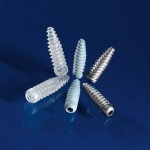The screws used by doctors to repair broken bones and torn ligaments enable recovery from a wide range of injuries. Unfortunately, they also leave holes in bones, require secondary surgery for removal, and make going through airport security a real pain. But by crafting the screws from a special designed composite of polymer and mineral, researchers at Germany’s Fraunhofer Institute have managed to solve all those problems in one fell swoop.
The researchers make the screws from a combination of polylactic acid, a biodegradable polymer already used to make surgical implants, and hydroxyapatite, the mineral that forms 50 percent of natural bone.
Like existing screws, the polylactic acid dissolves harmlessly in the body, saving patients the second surgery required for the removal of the older, stainless steel screws. Also, unlike regular polylactic acid screws, which leave gaping holes in bone, the hydroyxapatite interacts with the surrounding tissue to promote bone growth that naturally fills in the holes made by the screws.
And that’s not all! Manufacturing the screws out of the hydroxyapatite composite also simplifies production. Molding a pure polylactic acid screw requires temperatures around 2552 degrees Fahrenheit. By comparison, the mold for the hydroxyapitate composite screw only needs to reach 284 degrees, saving time, money, and energy.
Cheaper, healthier, and more energy efficient? Wow, Chalk one up for German engineering.
Popular Science… http://ow.ly/1ehWH

 The Orthopedics Industry
The Orthopedics Industry 